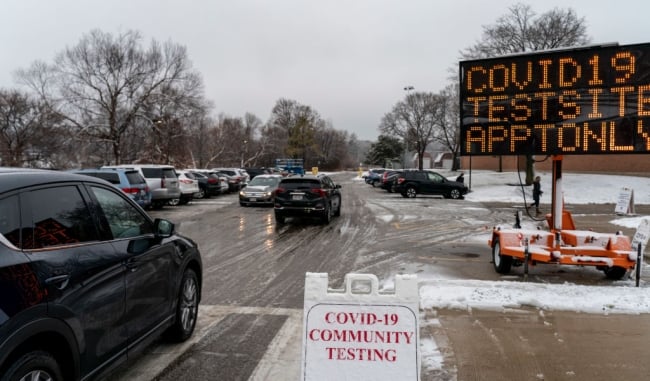You have /5 articles left.
Sign up for a free account or log in.

Andy Manis/Stringer via Getty Images
The pandemic presented an enormous financial challenge for colleges and universities this past fall as they reopened online or in person.
Institutions large and small had to cough up money for expenses related to COVID-19 testing, personal protective equipment and online learning resources. At the same time, they were bleeding tuition, housing and auxiliary services revenue.
Now data from higher education associations are starting to show how large the financial hits have been -- and how widely they range for different types of institutions.
One thing doesn't vary by institution type, according to experts at the associations. College leaders head into the spring term with several months of pandemic experience under their belt, but the financial burdens of COVID-19 are unlikely to ease up before the end of the academic year.
“The losses for our sector have just been huge, and they’re not going to go away instantly,” said Barbara Mistick, president of the National Association of Independent Colleges and Universities.
NAICU recently surveyed its members about their COVID-19-related spending and losses. Three-quarters of 68 institutions that responded to the survey said that COVID-19-related spending in the fall exceeded their expectations.
As many experts anticipated, most respondents reported that tuition and housing revenue declined. Many institutions -- 87 percent -- also reported falling auxiliary services revenue, which includes revenue from athletics or theater events, catering, rented space for weddings or conferences, and a host of other college side gigs.
The Association of Public and Land-grant Universities conducted a similar survey of its members and received 56 responses. The respondents were representative of APLU’s membership and included some flagship research institutions and a couple of historically Black colleges, said Bryan Cook, vice president of data and policy analysis at APLU.
Of all revenue categories, auxiliary services declines were the highest on average. Half of respondents reported losing between $5 million and $35 million in auxiliary services revenue compared with the previous fall. One institution reported losing $335 million.
Like the NAICU colleges, APLU respondents suffered extensive tuition and housing revenue declines. Half of the APLU respondents lost between $1.1 million and $13.5 million in tuition and fees revenue this fall when compared to previous fall numbers. Room and board declines were much higher: 50 percent of respondents lost between $4.3 million and $28 million in room and board revenue compared to last fall, according to the survey data.
About a quarter of NAICU respondents reported other revenue declines. The association left it up to respondents to decide what declines fell into a category to capture other types of lost revenue. Revenue related to study abroad programs and bookstores could be considered other revenue streams, Mistick said.
Both NAICU and APLU also asked their members about additional costs spurred by COVID-19. Technology and related training was the most frequently mentioned additional expense among NAICU respondents -- 94 percent spent some money on technology during the fall semester. About a quarter of responding institutions said it was their largest pandemic-related expense.
Three-quarters of NAICU respondents reported at least some costs associated with regular COVID-19 testing.
“Testing was truly the biggest surprise for everybody,” Mistick said.
Testing was also the largest expense for the APLU respondents -- 50 percent of respondents spent between $514,000 and $7.8 million on COVID-19 testing this fall.
Nine in 10 NAICU respondents spent money on face masks. Three-quarters paid for building modifications, and eight in 10 respondents reported costs associated with social distancing.
Half of the APLU respondents spent between $84,240 and $1.4 million on face masks and between $500,000 and $3.9 million to implement social distancing.
Institutions have a hodgepodge of additional expenses related to the pandemic that haven’t been captured by the APLU survey, according to Cook. Half of the APLU respondents spent between $921,000 and $6.6 million on other unidentified expenses.
“I think the one thing that jumped out as a bit of a surprise was in the safety measure costs -- that ‘other’ cost was actually the second-largest expense after testing,” Cook said. “We don’t have a real good sense of what that is.”
| Minimum | 25th percentile | Median | 75th percentile | Maximum | Mean | N | |
|---|---|---|---|---|---|---|---|
| Tuition and fees |
1,125,000 |
4,214,000 |
13,525,000 |
100,000,000 |
11,578,094 |
54 | |
| Room and board |
273,000 |
4,368,750 |
11,473,163 |
28,025,000 |
211,200,000 |
28,412,275 |
52 |
| Auxiliary services |
143,000 |
5,000,000 |
10,000,000 |
35,000,000 |
335,000,000 |
28,622,874 |
53 |
| Other revenue |
720,000 |
5,000,000 |
11,900,000 |
315,000,000 |
23,265,904 |
29 |
| Minimum | 25th percentile | Median | 75th percentile | Maximum | Mean | N | |
|---|---|---|---|---|---|---|---|
| Face masks |
84,240 |
408,684 |
1,400,000 |
20,000,000 |
1,318,033 |
51 | |
| Testing |
50,000 |
514,000 |
2,550,000 |
7,875,000 |
52,000,000 |
7,553,560 |
50 |
| Contact tracing |
52,500 |
472,000 |
1,250,000 |
30,000,000 |
1,560,107 |
42 | |
| Social distancing |
500,000 |
1,364,699 |
3,995,500 |
19,754,000 |
3,494,297 |
46 | |
| Dedicated residence hall |
450,000 |
1,000,000 |
2,550,000 |
17,000,000 |
2,374,914 |
36 | |
| Other costs |
80,000 |
921,000 |
2,489,750 |
6,627,250 |
40,000,000 |
5,011,173 |
40 |
The APLU and NAICU data provide much-needed high-level information about the financial challenges institutions faced this fall. Officials at individual institutions reported details that show how widely their experiences varied from campus to campus.
The University of Wisconsin system is still tallying its fall COVID-19 expense totals. As of Sept. 30, the system had spent $36 million on 350,000 COVID-19 tests and $43 million on out-of-pocket costs for personal protective equipment, sanitation, telecommuting, technology, staff time and student support. As of late September, the system had endured a net loss of $258 million due to revenue declines, added expenses and a state appropriations lapse related to COVID-19, said spokesperson Mark Pitsch.
Bellevue University, a private nonprofit university in Nebraska that enrolls about 9,000 students, spent $25,000 on personal protective equipment this fall, including face masks, hand sanitizer and Plexiglas barriers. The university also spent about $8,000 to sanitize work areas through a process called fogging, according to a university spokesperson, Cris Hay-Merchant.
Mesa Community College and Chandler-Gilbert Community College, both two-year public colleges in Arizona, spent a combined $1.4 million on technology-related expenses. Such expenses included professional development for online learning, new software, laptops for full-time employees and some students, and upgraded media systems. The two colleges also spent a combined $400,000 on personal protective equipment, such as masks, hand sanitizer and face shields, this fall.
Arapahoe Community College, a two-year public college in Littleton, Colo., reported spending $230,000 on personal protective equipment, about $33,000 to implement social distancing in classrooms, $46,000 on contract custodial services and $7,000 on contract tracing. The college also spent $430,000 on virtual learning and related expenses.
The fall survey numbers serve as a good barometer for what colleges should expect this spring, Mistick said. Routine COVID-19 testing, increased sanitation, personal protective equipment for students and employees, online learning options, and other COVID-19 prevention measures will still be necessary next term.
“I don’t think anyone thinks the vaccine is going to put a hard stop on the virus,” she said.
In some cases, pandemic-related expenses may increase, Mistick predicted. For example, as more families go longer without work, colleges may need to provide more financial assistance to students. As the pandemic drags on, colleges may also need to invest more in student and employee mental health resources, she said.








